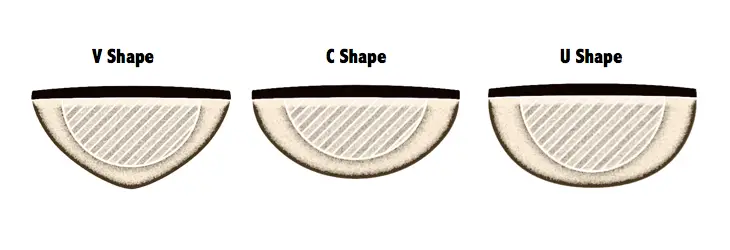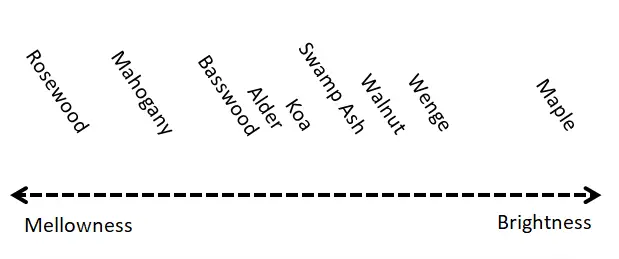Did you know there are THREE main guitar neck types? Understanding the different types of woods used for making guitar necks is important as it influences the feel, aesthetics, and tone of your instrument!
What are the different guitar neck types? There are THREE main types of Guitar neck and they ALL vary in shape and tonewood. These shapes include C shape, U shape and V shape. Which can also come in different types of tonewoods which include (not limited to) Rosewood, Mahogany, Maple, Wenge and Koa.
In this article, we will go over all the types of guitar neck in detail… Let’s jump right in!
1. What Is A Guitar Neck?
The guitar neck is the piece of wood located between the headstock and the body. It sits under the fretboard.
It is important to note that the guitar neck is not the same as the fretboard and can both be made of entirely different material. Usually, the fretboard is glued on top; however, there are occasions when you will see the guitar neck and fretboard being a single piece of wood. The different types of guitar necks change due to the wood types.
2. Why Is a Guitar Neck Important?
The guitar neck holds the fretboard and has a metal beam (aka Truss Rod) that helps counteract the tension created by the guitar strings and overall stabilise the tuning accuracy.
Furthermore, the material which the guitar is made from will be one of the defining characteristics of a guitar. It will greatly influence its tone, playability and aesthetics. Deciding on the tone woods for your guitar neck will be a question of deciding between warmth and brightness. The warmer sounding your tone becomes the less brighter it is and vise versa.
3. Guitar Neck Shapes
Guitars are not only designed with distinctive body shapes, but they also differ in the neck shape. A guitar’s neck shape – also referred to as the “neck profile” is the back of a guitar’s neck if viewed cross sectionally. This part of the guitar – however designed, neither affects nor changes how the instrument sounds, in fact, but rather determines the way guitarists play the instrument, thus contributing significantly to creating the particular feel a guitar may bring to the player.
Although a guitar neck can now be designed and made to any shape as requested by guitar players, neck profiles usually fall into 3 main categories: C, U and V shape. The reason why the shapes are named after these letters is because the shape of the letter C, U and V physically resemble the shape of the back of the guitar’s neck viewed cross sectionally. If they were to be compared, there’s not any shape that’s better than the other, because it’s just a matter of the player’s personal taste. Normally, guitar players would opt for the neck shape that makes them feel the most comfortable playing. Some neck shapes would provide more comfort and significant ease when playing certain notes than others, and that’s more than enough to persuade a guitar player to purchase.

Hereby, I’m going to go through the features of the 3 most common neck shapes mentioned above in more details, what each shape offers, and what makes them preferred by certain players.
V shape:
Generally, V-shaped necks are considered something “old-school” and are often seen on older guitars or reproduced instruments. This type of neck profile is commonly known to be divided into 2 types: “soft V” and “hard V”. The soft V shape is associated with a rounder profile, with the point of the V fitting into the gap between the thumb and the pointer finger of the player. Famous models built with a soft V neck include the 1960 Stratocaster and the SRV Stratocaster.
The hard V neck shape, just like its name, has a pointed apex. Though offering the same tone as the soft version, the hard V is preferred by many players over the soft V because it enables them to hang their thumbs over the fingerboard. The hard V often shows up on vintage guitars and reproductions of older guitar models only and is rarely seen on modern guitars.
C Shape:
Similar to the shape of the letter “C”, this type of neck profile is a round shape, about half an oval and is the most popular modern guitar shape. The reason behind its popularity is because this shape offers very easy grip and cups most player’s hands perfectly, thus widely recognized by guitarists as the neck profile that’s ideal for playing any styles. The thinness of this shape also enables players to play with higher speed because they can move their hands easily. However, the downside of thin necks in general is that it is prone to warping and not very durable in the long term, thus requires more regular maintenance compared to thicker necks.
Some Fender versions are now designed with a flatter C shape, but the original shape remains. There are now actually a lot of variations of the C-shaped neck – from slim, extra-slim to fat, nut-shaped, and huge.
U shape:
The U shape is quite similar to the C shape, with a roughly identical radius but with higher shoulders. This shape is usually referred to as “bulky”, like a big chunk, while some players also compare it to a baseball bat. This type of neck profile, therefore, is the most suitable for players with large hands or people who favour placing their thumb on the side or the back of the neck.
The most famous models made with this shape are the Telecaster, as well as the Fender Nocaster. U-shaped necks can be made either with perfect balance or thicker on one side than the other, all up to the player’s preference. In fact, many players now fancy thick necks not only because they offer a sturdier feel, but also because they are rarely subject to warping due to changes in heat compared to thin necks.
The U-shaped neck, however, may cause huge discomfort for players with small or average sized hands. They will not only struggle when holding and playing, but they may also be injured when trying to reach certain notes.
4. Guitar Neck Tonewoods
While its common knowledge that there are different types of guitar necks, it is much less common to understand the different tonewood types used to construct the guitar neck and their associated advantages. The wood types build the tonal foundation for every guitar and so it is important to understand their tonal characteristics. For example, some woods can make your guitar appear mellow in sound while others are brighter.

It is the density of the grains in the wood that cause these tonal characteristics. If wood is dense, there will be less space among the grain for the sound to move around in, so you can expect quick attack and bright clarity. If the wood is softer, the sound will have more space in the grain to move around in, so you can expect a darker resonance with increased sustain!
Even though each wood represents a certain tone two samples of the same wood could also be slightly unpredictable in sound. This is because wood is ever-changing and quite inconsistent due to its organic nature. You can almost certainly expect inconsistencies and imperfections at every level of detail which makes them sound different from each other.
5. Multiple & Single Wood Types
Just to make things slightly more complicated guitar necks will be built with the consideration of multiple woods or single woods. Sometimes you prefer single grain wood types which mean the guitar neck and fretboard is all manufactured from one piece of wood. However, you can mix and match these wood types of the guitar neck and fretboard to get complimentary vibrations. We will discuss these in turn below…
Firstly, let us talk about a single-piece neck on a guitar. Some guitarists prefer the purity of a single grain tone wood that speaks to people. This is because you are getting a more natural resonance as each tone wood has somewhat of a signature sound. However, manufacturing a guitar neck with a fretboard in a single piece of wood is a more technical process of production and often more expensive as a result. Further, single wood guitar necks are more susceptible to warping because there is no reinforcing glue due to only being a single piece.
Now we have discussed single wood let us move onto multiple wood types. Many guitar necks are made from two pieces of wood. Some guitarists prefer a guitar neck and fretboard to have two separate strands of wood. This can affect the tone and strength of the guitar neck as well as making the manufacturing process easier. The Glueing process provides a tight bond between the connecting wood. This is said to make guitars even stronger than if it was just the organic wood. Whereby, it is said they last longer and possibly even resonate better. In terms of tone, it is having two types of wood that complement each other that can give you a full tone. For example, lets says if you glue together Mahogany with Maple your tone will have the warmth of mahogany and brightness of Maple providing you with a full well rounded tone.
6. Rosewood Guitar Necks
Rosewood is probably one of the most popular materials you will find on a guitar. It is used a lot because it mutes the overtones and smoothens out the high frequencies.

These high frequencies can otherwise get in the way of your true sound. It also enhances the sustain which will also increase the brightness. However, Rosewoods have a more present low and mid frequencies which produce an overall warm tone.
7. Mahogany Guitar Necks
Mahogany is a very dense material adding to the stability of the neck reducing the risk of warping. Mahogany is a type of wood that has open pores, you can literally feel the grains if you run your finger over it. The density and open pores helps compress the sound as it absorbs the vibration smoothing out the attack.

This type of wood has a good name for itself usually because it produces a really big / fatter sounding output that is smooth. Being an open grain wood will usually require more work to finish and smooth out when in the manufacturing process.
8. Maple Guitar Necks
Maple is the tone wood with highest density making it hard and strong. Due to these characteristics it brings with it great sustain and stability. This is perfect material in combination with its bright tone; you can see why it is used as the default option for Fender guitars.

Maple has a uniform grain. It is relatively smooth in comparison to Mahogany which aids to its brightness. It is less reactive to the environment making it more stable and having less tuning problems. It is also better for a bolt on neck design as it doesn’t affect the tone as much and is good at transferring the vibrational energy to the body.
Overall, Maple tone wood creates a thiner, twangier sounding brightness that can get maximum sound quality through a bolt-on neck. All in all, you can see why Fender choose this tone wood and is a fundamental asset to the Fender brand.
9. Wenge Guitar Necks
Wenge is a black open grain hardwood with brown stripes that run through it. This wood is more commonly found on bass guitar necks however, it is sometimes found on electric guitars. It is ideal for bass because of it has a strong mid-range and overall warm tone. You can combine this with an Ebony fretboard and it adds more brightness for an overall full sound.

This wood does not usually have finish applied and it stays natural. Similar to Rosewood, Wenge smoothens out the higher pitch giving more space for the mids. This usually has less distinguished overtones as the overtones resonate more from the mids.
10. Koa Guitar Necks
Koa guitar necks are a good balance between Mahogany and Maple as they are a good mixture of warm and brightness. It is a top end frequency range.

You will usually find this wood will be combined with an Ebony fretboard as they compliment each other very well.
Conclusion
In this article, we discussed in brief about guitar necks and their tone woods. When choosing a tone wood for the guitar neck we usually have to consider which tone woods work well together. This combination of tone wood usually provides a good foundation to the type of tone your guitar resonates. As discussed, Mahogany usually works well as a guitar neck with a Maple fretboard. But, the rule of thumb is combining woods which have a good balance of brightness and warmth.
If you liked this article and you feel it helped you then please leave a comment and share it with someone who might find it useful. I am actively updating these articles daily and so I will see any comments made within a few days of posting!You can also visit Parts Of A Guitar? If you want to find more relevant posts to read.
Thank you so much and have a great day!

